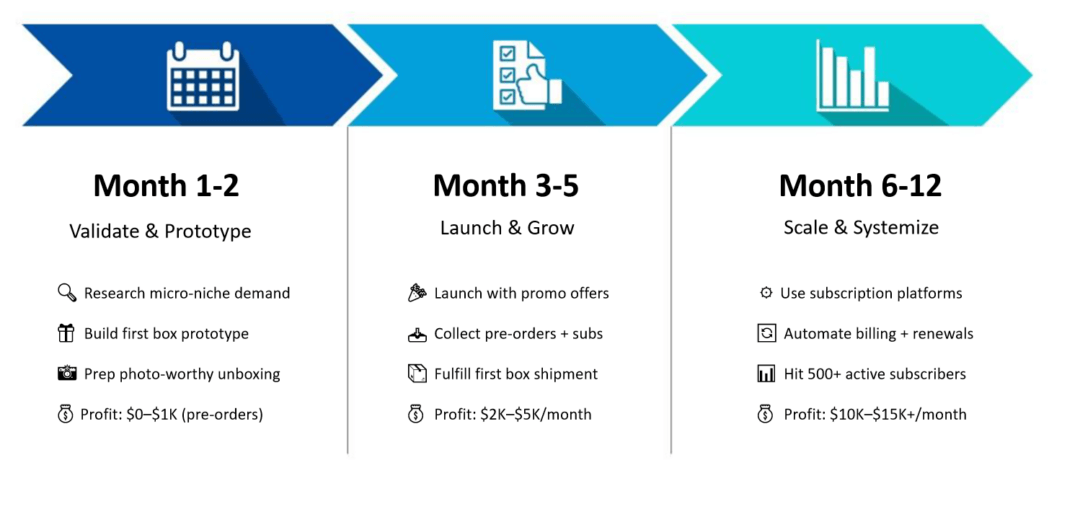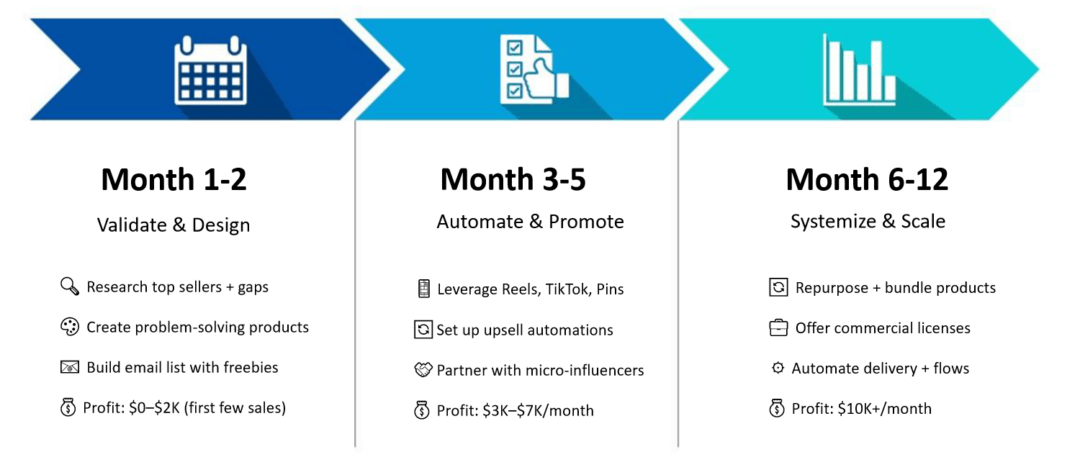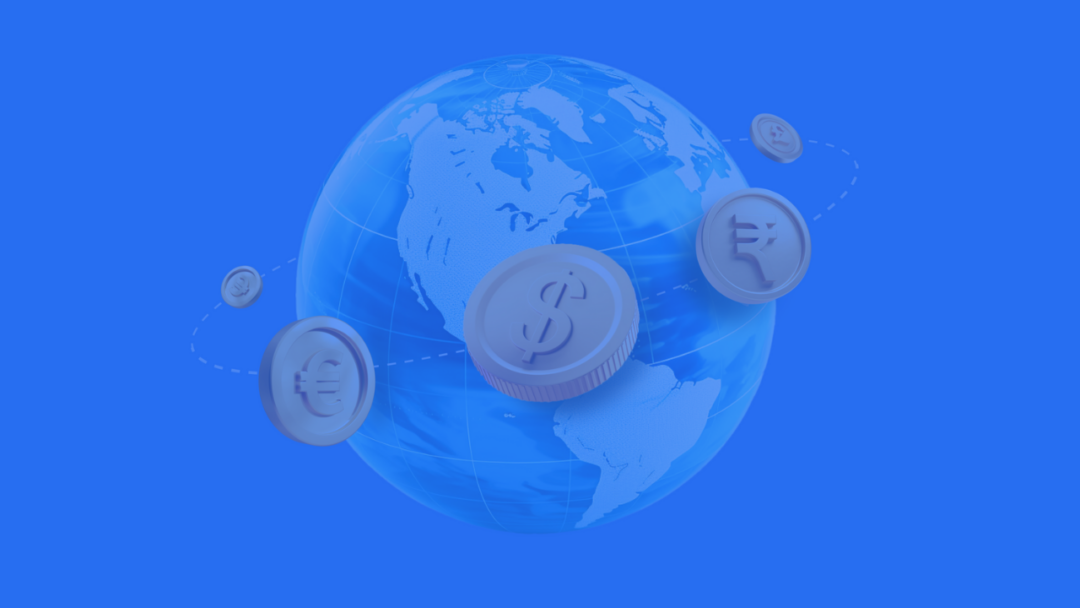Language:
7 E-Commerce Business Ideas That Can Make You $10K+/Month

If the e-commerce world is swimming in capital and billion-dollar blueprints… why isn’t everyone building the next Gymshark or Allbirds?
Simple: too many aspiring founders are chasing viral TikTok trends and generic e-commerce business ideas without ever building a real foundation.
But if you’re serious about building a real online business, one that actually has the potential to generate $10K+ per month, you’re in the right place.
Because today’s guide isn’t just another recycled list. It unpacks 7 high-performing, revenue-ready e-commerce business ideas that actually work.
We’ll also break down what it takes to set up and run these businesses legally, smoothly, and profitably— with doola as your go-to partner.
Why E-Commerce Business Ideas? The $10K+/Month Potential
With over 2.64 billion people shopping online and global e-commerce sales set to eclipse $8.1 trillion by 2026, e-commerce has become a digital gold rush.
However, if you’re aiming for consistent $10K+ months, you need more than trending e-commerce business ideas. You need a strategy rooted in high-margin niches, repeatable revenue, and business models built for scale, not burnout.
So, ditch the generic playbook. Let’s explore the e-commerce business ideas that deliver five-figure months and build digital empires in the process.
7 Profitable E-Commerce Business Ideas in 2025

In this section, we present 7 e-commerce business ideas proven to scale past $10K/month, and built for entrepreneurs looking to stand out—and sell out.
Let’s get you started.
1. High-Ticket Dropshipping
Why sell 100 phone cases for $20 when you could sell 10 electric bikes for $2K? That’s high-ticket dropshipping for you!
If traditional dropshipping is the hustle, high-ticket dropshipping is the heist— legal, ethical, and wildly profitable.
We’re talking about selling premium products, from $500 to $5,000 a pop, like electric bikes, standing desks that remember your ideal height, or smart security systems that could out-think a Bond villain.
And instead of chasing hundreds of low-margin sales, you scale by making fewer, smarter sales that pay big.
Why Is High-Ticket Dropshipping Profitable?
High-ticket dropshipping is the smarter cousin of traditional e-commerce, where every sale moves the needle, and you’re building a brand, not burning out.
And with margins of $300–$700 per order, hitting $10K/month could mean just 15–20 well-placed sales. That low volume gives you more time to deliver a premium experience, build real customer relationships, and scale efficiently.
Now, let’s uncover the niches crushing it in the high-ticket game:
| Niche | Product Example | Average Retail Price |
|---|---|---|
| Electric Mobility | E-Bikes, E-Scooters | $1,500 – $3,500 |
| Office Comfort | Ergonomic Chairs, Standing Desks | $700 – $1,800 |
| Smart Home Security | Video Doorbells, AI Surveillance | $900 – $2,500 |
| Home Fitness | Rowing Machines, Treadmills | $1,800 – $5,000 |
| Gourmet Lifestyle | Espresso Machines, Wine Coolers | $1,000 – $3,000 |
Pro tip: Bundle or upsell with accessories (bike locks, chair mats, smart plugs) to increase your AOV without increasing ad spend.
The Strategy to Hit $10K+/Month in Profit

Gearing up to mint money with high-ticket dropshipping? Let’s build you a roadmap.
🚀 Step 1: Start Strong with the Right Business Structure
Establish an LLC to work with high-end suppliers and payment processors confidently. With doola’s services, you can form your US business from anywhere in the world and stay audit-ready.
🚀 Step 2: Choose a Niche That’s Profitable and Practical
Look for niches with low competition but high perceived value. Think hard-to-find local alternatives or products with recurring revenue potential (like accessories or refills).
For example, instead of just selling yoga mats, focus on eco-friendly yoga kits for urban professionals with wellness routines.
🚀 Step 3: Secure VIP-Grade Suppliers
Simply put, lock in VIP-grade suppliers who won’t ghost you mid-surge. Use platforms like Spocket, SaleHoo, or even AliExpress to scout, but always aim to negotiate directly with suppliers to get the best margins and service guarantees.
🚀 Step 4: Create a Luxe Shopping Experience
Your store shouldn’t feel like a bargain bin. Whether you’re selling $50 tech gadgets or $200 minimalist furniture, the customer experience should be top-notch.
Use Shopify or WooCommerce with a sleek theme, invest in high-res product photos, and show your items in real-world, lifestyle settings to boost conversions.
🚀 Step 5: Ads That Speak to the Big Spenders
Smart advertising is where the real momentum starts. Google Shopping and Facebook Ads are your go-to engines for targeted traffic. But also:
Want to level up faster? Partner with micro-influencers who dominate niche spaces, like Home GymTok, plant mom YouTube, or biking gear Reddit threads.
🚀 Step 6: Automate, Then Dominate
Use automation to save time and multiply your efforts. Platforms like Shopify and Zapier streamline your order flow. Email tools like Klaviyo help you recover abandoned carts and upsell to past buyers.
Profit Breakdown: How the Math Works
You’ve got your e-commerce business ideas, the niche, and the vision. Now let’s make sure the math adds up to your $10K/month goal.
| Metric | What It Means | Example Value |
|---|---|---|
| Avg. Order Value (AOV) | The average customer spend per order | $2,000 |
| Profit Margin | The percentage of revenue you actually keep | 25% |
| Profit per Order | Your take-home from each sale | $500 |
Now suppose, you’re making $500 profit per sale. So how many sales do you need to hit $10,000 in monthly profit? Let’s explain:
| Goal | Calculation | Result |
|---|---|---|
| $10K Profit Target | $10,000 ÷ $500 per order | 20 sales |
| Sales per Week | 20 sales ÷ 4 weeks | 5/week |
| Sales per Day | 20 sales ÷ 30 days | ~1 sale every 1.5 days |
So just 1 sale every other day can unlock five figures in profit. And with only 20 happy customers a month, you’re running a profitable brand!
Additionally, with doola’s services, you can build a cash-generating, customer-obsessed e-commerce machine.
2. Subscription Box Business
From niche snack boxes to pet toys, the subscription e-commerce model delivers recurring revenue on autopilot. Let’s find out what makes subscription boxes one of the profitable e-commerce business ideas.
Why It Works
The built-in predictability and potential for long-term customer loyalty makes the subscription box model a profit magnet.
With recurring billing cycles—monthly, quarterly, or annually—you gain a clear, consistent view of your revenue, making it easier to forecast growth and manage inventory.
Real-World Examples of High-Performing Niches
The most successful boxes combine high perceived value, lifestyle appeal, and a reason for customers to keep coming back.
Here’s a breakdown of top-performing niches and brands:
| Niche | Subscription Box Type | Avg. Monthly Price | Examples |
|---|---|---|---|
| Pet Supplies | Dog Toys & Treats | $30 – $50 | BarkBox |
| Health & Wellness | Vitamins / Mindfulness Boxes | $40 – $60 | TheraBox |
| Gourmet Snacks | Global or Vegan Snacks | $25 – $40 | Universal Yums, SnackMagic |
| Eco-Friendly Living | Sustainable Home/Beauty Products | $30 – $50 | Earthlove, GreenUp |
| Hobbies & Craft | Art Kits, Journals, DIY Projects | $25 – $40 | SmartArt Box, Papergang |
| Kids Educational Boxes | STEM Learning Kits | $30 – $50 | KiwiCo, MEL Science |
Let’s now explore the standard path and strategy followed by these brands.
Roadmap to $10K+/Month

Subscription boxes can create recurring revenue while delivering value to a highly engaged audience.
Here’s how you can build a subscription box business that generates $10K/month and beyond.
🚀 Step 1: Validate Your Niche
Instead of casting a wide net with something generic like “snacks” or “beauty,” think in micro-movements like vegan snacks for hikers, eco-friendly kits for new moms, or journaling boxes for Gen Z creatives.
Tip: Explore platforms like Reddit, TikTok, and Facebook groups where your ideal customers are hanging out, ranting about what’s missing—and waiting for someone to deliver it.
🚀 Step 2: Build a Prototype Box
Start sourcing products from wholesalers or small-batch creators. Many offer free samples or starter deals for first-time entrepreneurs.
Use visually appealing packaging, a well-designed insert, and that Instagram-worthy “wow” factor to turn your prototype into a content magnet.
🚀 Step 3: Set Pricing for Profit
Calculate your total Cost of Goods Sold (COGS), factoring in everything from product cost and packaging to shipping and payment processing fees. Aim for a healthy gross profit margin between 40-60% to keep things sustainable.
For example, if you charge $40 per month and your total COGS is $20, you’re earning $20 in gross profit per box. That means, landing just 500 subscribers puts you at $20,000 in revenue and $10K profit month.
🚀 Step 4: Launch Loud and Proud
A quiet launch is a missed opportunity. Build anticipation with early-bird pricing, limited-time discounts, and giveaways that get people talking (and tagging).
Tip: Pre-orders are another clever move. By collecting payments before fulfillment, you create urgency, validate demand, and secure cash flow to fuel your first batch.
🚀 Step 5: Use Subscription Platforms
Lean on the right tech, always. Platforms like Chargebee, Recharge, Bold Subscriptions integrate directly with Shopify and take the stress out of recurring billing.
These platforms handle subscription management, payment retries, upgrades, and more—so you can focus on growth while your back-end runs like clockwork with a little help from doola.
3. Print-on-Demand (POD) With a Niche Focus
The Print-on-Demand businesses that crack $10K+/month all share the same DNA: they speak directly to a passionate niche.
Whether it’s bookworms, dog moms, beekeepers, tattoo artists, proud introverts, or gymgoers— people love representing their identity on stuff they use daily.
Let’s break down what it really takes to build a six-figure POD brand.
Why Niche POD Works
When you go niche, you’re not just selling products; you’re tapping into built-in communities that already exist and engage daily on TikTok, Reddit, Facebook Groups, and Discord servers.
And while most sellers get lost in generic e-commerce business ideas, you go micro—earning loyalty, virality, and repeat buyers who proudly wear their identity on their sleeves (literally).
Top POD Categories That Dominate Niche Markets
Let’s break down real products that niche sellers are crushing with and why they work.
| Product Type | Why It Works in Niches | Example Niches & Ideas |
|---|---|---|
| Graphic Tees | Tribe identity, humor, bold self-expression | “Powered by Deadlifts & Espresso” (Fitness niche) |
| Mugs | High daily-use + emotional/lifestyle expression | “Dog Hair Is My Glitter” (Dog moms) |
| Canvas Wall Art | Home décor with identity = great perceived value | “Introverting in Progress” (Mental health advocates) |
| Tote Bags / Hoodies | Wearable identity = walking billboard | “Plant Lady Club” (Plant moms) |
These e-commerce business ideas are timeless. Unlike trend-chasing, niche identity products thrive year-round and can easily ride seasonal waves (Mother’s Day, Halloween, etc.).
From Zero to $10K/Month: The Niche POD Growth Engine

When a fantasy-loving creator launched The Bookish Raven— a dark academia Etsy store packed with witty, bookish merch —she didn’t aim small.
A single viral TikTok, fueled by smart micro-influencer partnerships, turned her “Plot Twist Enthusiast” hoodie into a fan-favorite.
In just 60 days, she crossed $30K in revenue with over 65% profit margins.
And you can hit this milestone too! Let’s map out how to turn your niche POD brand into a $10K/month machine.
🚀 Step 1: Sell the Experience, Not the Product
Great POD brands sell identity. So focus on emotional alignment.
Who is your customer when no one’s watching? A sarcastic dog mom? A gym-goer with a rigorous fitness regime ?
Find the soul of your niche and turn it into a phrase they’d proudly wear in public.
🚀 Step 2: Launch Fast, Ugly, and Intentional
The faster you launch, the faster you learn. You need 3–5 designs that feel real, not polished. Upload them to Etsy, connect to Printify or Gelato, and set prices with a clear goal: ~$20 profit per item.
So $10K/month = just 500 orders. That’s 17 per day.
And you don’t need a million people, you need the right 500 who feel seen by what you’ve made.
🚀 Step 3: Fuel with Micro-Reach, Not Mega-Spend
This stage isn’t about running $1K ad campaigns. It’s about getting 10 creators with 10K followers to post with loyalty.
Gift your best product. Give them an affiliate link. Let their niche trust carry you. Add $5/day interest-based TikTok or Meta ads to test angles and hooks.
Ultimately, if your product speaks the language of the subculture, it only takes one video to explode.
🚀 Step 4: Stack Your Value with Smart Bundles
Always turn your best-sellers into a collection: matching mugs, stickers, coasters, hoodies. Bundle them into themed sets that feel curated, not random.
This is how you raise your AOV (average order value).
🚀 Step 5: Systemize to Scale
Once your store is moving, chaos will sneak in. Orders pile up. Messages flood in. Analytics become guesswork.
This is your cue to shift from creator to founder mindset. Automate all you can. From 1,000 sales onward, every hour you reclaim is a lever for growth.
Want to build your niche POD empire and keep your books investor- and IRS-ready while you’re at it?
Book a demo with doola today!
4. Digital Product Store (Courses, E-books, Templates)
With no shipping costs and zero inventory, digital products are a creator’s dream!
From e-books and design templates to downloadable workbooks and online courses, digital goods offer some of the highest profit margins.
Because once created, they can be sold again and again, with no added cost.
Why This Can Be a $10K+/Month Business
Let’s break down a realistic income model:
| Product Type | Price Point | Sales/Month | Monthly Revenue |
|---|---|---|---|
| Canva templates bundle | $29 | 350 | $10,150 |
| Mini-course (video) | $49 | 250 | $12,250 |
| Budgeting e-book | $19 | 600 | $11,400 |
Even selling a $29 Canva template bundle to just 12 people a day can rack up over $10,000/month. And unlike physical products, you don’t need to restock or deal with returns.
Niche Digital Products That Actually Sell
Here’s a list of digital (and printable) products that are winning and are built for repeat buyers:
- Finance & Wellness Fans: Customized budget trackers, minimalist meal planners, and dopamine-boosting habit systems.
So, how do you turn these e-commerce business ideas into a $10K/month machine?
Let’s break it down.
$10K+/Month with Digital Products

Making $10K/month from digital products isn’t a stretch; it’s a system. Here’s how creators are making it happen:
🚀 Step 1: Validate Before You Create
Scan top performers on Gumroad, Etsy, and Creative Market. What’s trending? What’s missing? Read reviews to spot gaps— and create with precision.
🚀 Step 2: Design What Solves, Not Just Sells
Use tools like Canva, Notion, or Figma to craft polished, plug-and-play templates or toolkits. Prioritize design that solves a problem instantly.
🚀 Step 3: Funnel First, Always
Give away real value (e.g., a 1-pager or lite version of your product) to collect emails. Then upsell the premium version through automations that do the heavy lifting.
🚀 Step 4: Promote Like a Creator, Not a Seller
Reels. TikToks. Pinterest Pins. These are your megaphones. Optimize listings with strong SEO, and partner with micro-influencers who already “get” your niche.
Virality beats ad spend when your product speaks to emotion.
🚀 Step 5: Scale With Systems
As your sales grow, expand horizontally. Repurpose for new audiences (e.g., budgeting planner for creators). Bundle complementary products into value-stacked kits.
Offer commercial licenses for agencies and freelancers. Add urgency with limited-time drops or seasonal launches. Launch an affiliate program to turn buyers into marketers.
Finally, let doola handle the real back-end: business formation, tax filing and compliance, and ensuring your business is audit-proof.
5. Private Labeling and White Labeling
Private and white labeling let you skip the whole manufacturing chaos while still slapping your brand on products people love.
Private labeling involves partnering with a manufacturer to produce products exclusively for your brand. You have control over product specifications, design, and branding, resulting in unique offerings tailored to your target market.
White labeling is where a manufacturer produces generic products that multiple retailers can rebrand and sell as their own. Customization is limited to branding elements like logos and packaging.
Now, let’s look at a few product examples across various niches.
| Niche | Private Label Product Example | White Label Product Example |
|---|---|---|
| Beauty & Skincare | Organic facial serums with custom formulations | Standard moisturizers with your branding |
| Health Supplements | Personalized vitamin packs | Generic multivitamins in branded bottles |
| Tech Accessories | Custom-designed ergonomic keyboards | Standard phone cases with your logo |
| Home Goods | Eco-friendly, uniquely designed cookware | Generic kitchen utensils with branding |
But how are these e-commerce business ideas acing the $10K+/Month Game? Let’s find out.
The $10K+/Month Game Plan

Let’s break down the blueprint to scaling a private/white label brand to consistent five-figure months:
🚀 Step 1: Own a Niche, Don’t Just Rent It
Use Google Trends, TikTok search, Reddit threads, and keyword research tools like Ubersuggest or Semrush to spot rising demand in underserved markets.
Get micro-specific with your niche, e.g., “dermatologist-approved skincare for melanin-rich skin” or “eco-friendly pet grooming kits for doodle owners.”.
🚀 Step 2: Product and Supplier Strategy
For private labeling, find manufacturers open to customizing ingredients, materials, or features—whether it’s tweaking a serum formula or adding unique eco-packaging.
Alibaba, ThomasNet, or even trade shows are great places to source partners.
Want speed to market? White labeling lets you slap your brand on proven products with great reviews and focus on brand and sales from day one.
Tip: Vet every supplier thoroughly. Look for low MOQs, reliability, and samples that meet your quality bar.
🚀 Step 3: Build a Scroll-Stopping Brand
Develop a brand identity that oozes authenticity and trust. Think of Glossier’s “Skin First. Makeup Second” branding or Olaplex’s clinical-chic minimalism.
Simply put, make people proud to show off your product in their shelves and hauls.
🚀 Step 4: Launch a Conversion-Driven Online Store
Use platforms like WooCommerce or Shopify to build your store, or go the Amazon FBA route if you’re optimizing for traffic volume.
Just make sure your site loads fast, looks sleek on mobile, and guides users from homepage to checkout seamlessly.
🚀 Step 5: Go Loud with Launch Marketing
TikTok, Insta Reels, and UGC from beta customers will give you social currency fast. Encourage customers to share unboxings and results with incentives or affiliate perks.
Once your messaging clicks, level up with paid traffic. Meta (Facebook/IG) and Google Ads are your power levers, especially with retargeting campaigns.
🚀 Step 6: Handle Fulfillment Like a Pro
Partner with a solid 3PL (Third-Party Logistics) provider to handle storage, pick-and-pack, and shipping. And always set up inventory alerts, automated restocking triggers, and tight lead times with your supplier.
Let’s now talk numbers and reverse-engineer the profit math for you.
Your Financial Projections
Let’s say you’re selling a white-labeled skincare kit for $50.
To hit $10K/month, you need 400 monthly sales. That’s just over 13 orders a day.
With a strong offer, consistent traffic, and high retention, this number is totally doable— and scalable.
Here’s a summary of your potential costs with private vs white labeling:
| Expense | Private Labeling | White Labeling |
|---|---|---|
| Product Dev | $5K – $15K | N/A |
| Initial Inventory | $10K – $25K | $5K – $10K |
| Branding + Packaging | $2K – $5K | $1K – $3K |
| E-Commerce Setup | $2K – $5K | $2K – $5K |
| Marketing & Ads | $5K – $10K | $3K – $7K |
| Legal/Admin | $1K – $3K | $1K – $3K |
| Total | $25K – $63K | $12K – $28K |
Need help with tax filing while you scale your empire? doola Tax Filing has your back with clean, audit-proof financials that keep investors, banks, and the IRS happy.
6. Localized Niche E-Commerce Stores

Remember The Peach Truck that started selling Georgia peaches from a truck and now operates a full-scale ecommerce operation delivering nationwide?
That’s the power of localized niche e-commerce business ideas. It’s about zooming in—on a city, a subculture, or a diaspora—and building an online brand that gets them in a way mass retailers never will.
Why This Model Works (and Scales)
Localized niche e-commerce business ideas tap into deep emotional resonance. When your products reflect local pride, cultural quirks, or regional inside jokes, customers feel an instant connection.
And, these niches are an SEO goldmine; local and cultural keywords tend to have high search intent but low competition, making it easier to rank and convert.
Now let’s look at brands that have turned this strategy into real wins:
| Niche | Product Ideas | Why It Works |
|---|---|---|
| City Pride Apparel | Tees with “Brooklyn Made” or “Austin Vibes Only” | Hyper-local lingo + community identity = repeat buyers |
| Diaspora Spices & Snacks | Gujarati farsan boxes in Texas, Filipino snacks in Dubai | Fills cultural cravings global supermarkets don’t |
| Event-Based Local Merch | Custom merch for NYC marathons, local Pride fests, music fests | Seasonal spikes + emotional value |
| Indigenous or Cultural Goods | Navajo-designed homeware, Maori-inspired jewelry | Supports artisans + sells cultural meaning |
| Hyper-Niche Pets | Gear for desert dogs in Arizona or cold-weather cats in Canada | Local climate + pet parenting = loyal tribe |
And now, let’s also try and implement their blueprint.
$10K+/Month Blueprint

Here’s how to build niche e-commerce stores that speak to your community and your bottom line:
🚀 Step 1: Nail the Product-Market Fit
Dive into Facebook Groups, Reddit threads, and Google Trends to uncover what your community is buzzing about. Run quick polls in local forums or on IG Stories to test product ideas.
Tip: Soft launch on platforms like Etsy or Shopify to validate before you scale.
🚀 Step 2: Choose the Right Fulfilment Model
For merchandize or accessories, start lean with print-on-demand. White label to test fast, then graduate to private label as revenue climbs.
🚀 Step 3: Build Your Brand Around Local Pride
Speak the culture, literally. Use local lingo, shout out neighborhood landmarks, and inject regional flavor into every product description and Instagram caption.
Campaigns like “#OnlyInAustin” or “Toronto Things” are catnip for engagement and user-generated content.
🚀 Step 4: Pick Your Sales Channels Strategically
Your Shopify store is your home base, but branch out. Use Etsy for handmade/local credibility, or plug into Amazon Local for mass reach.
Explore regional marketplaces like Not On The High Street (UK) or Faire to connect with indie-loving buyers.
🚀 Step 5: Optimize for Localization
Provide bilingual customer support and tailor product details like sizing and measurements to match regional norms. Make checkout seamless by displaying prices in local currencies along with accurate shipping estimates.
And don’t forget your SEO: opt for hyper-local keywords (e.g., “best goth merch in Austin” vs. generic tags) to attract high-intent, location-based traffic.
Let’s Do the Math: $10K+/Month with Localized Trekking Gear
Let’s say you launch an e-commerce brand called “ChiTrek Supply Co.” selling a Midwest-inspired, cold-weather-ready trekking gear tailored for Chicago trails.
Now, start offering a Chicago Trail Kit Bundle that includes:
- Collapsible hiking bottle with “Hike Illinois” motif
- Local trail snack pack or trail log insert (upsell potential)
Price it at $85, and if your COGS (gear + packaging) stands at $34, you earn a net profit of $51 per kit. And just 7 daily orders take you past the $10K/month mark!
Next, here’s how you scale it:
| Channel | Strategy | Result |
|---|---|---|
| TikTok/IG Reels | Showcase real hikers unboxing ChiTrek bundles mid-trail | Builds social proof, boosts conversion |
| Micro-Influencers | Partner with 3-5 Chicago hiking influencers (1-10k followers) | Targeted, affordable reach |
| Google Ads | Geo-target “hiking gear Chicago” / “Illinois trekking kit” | High-intent traffic |
| Trail Pop-Ups | Set up booths at popular trailheads or REI meetups | Instant sales + email list growth |
| Email Funnel | Offer free “Top 10 Chicago Trails” download | List-build magnet, cross-sell bundles |
From niche gear to cult-favorite ecommerce, this is how $10K/month looks when your brand feels like home!
Looking to bring your niche e-commerce business ideas to life?
Book a demo with doola and take the first step toward building your $10K+ e-commerce brand today.
7. Automated Affiliate E-Commerce
Automated affiliate e-commerce is the perfect integration of content marketing, smart funnels, and affiliate partnerships to create a digital storefront that sells everything—without ever touching a product.
Done right, this model can bring in $10K+ per month in affiliate commissions.
What Is an Automated Affiliate E-Commerce Store?
It’s your curated product marketplace powered by content. You build a niche-focused e-commerce site (say, minimalist home gym setups or eco-friendly travel accessories), then embed affiliate links from top platforms like ClickBank, Amazon Associates, ShareASale, CJ Affiliate, etc.
When users click your product links and make a purchase, you earn a commission— anywhere from 3% to 50%+, depending on the network and product type.
Here’s how affiliate e-commerce is more profitable than traditional e-commerce:
| Element | Automated Affiliate E-commerce | Traditional E-commerce |
|---|---|---|
| Inventory | ❌ None | ✅ Yes |
| Shipping & Fulfillment | ❌ Not your job | ✅ Your full-time job |
| Startup Costs | Low (hosting + domain + automation tools) | Higher (inventory, storage, packaging) |
| Profit Margins | High (since there’s no COGS) | Depends on markup |
| Scalability | Passive & content-driven | Requires ops scaling |
| Risk | 📉 Very Low | 📈 Moderate to High |
Let’s now find out which affiliate e-commerce niches work and why.
| Niche | Affiliate Programs | Why It Works |
| Home Office Upgrades | Amazon, ShareASale, FlexiSpot, Branch | Remote workers, solopreneurs, and creators are always optimizing their space |
| Wellness & Biohacking | ClickBank, Organifi, iHerb, Onnit | High AOV + loyal customer base + evergreen search traffic |
| Pet Gear | Chewy Affiliate, Amazon | Pet owners love buying premium and quirky products for their fur babies |
| Creator Tools | Canva, Jasper, ConvertKit | Exploding with creators monetizing content and needing tools |
| Travel Hacking | Booking.com, Travelpayouts, Wise, Nomad Insurance | Affiliate-rich niche for flight finders, insurance, hotel bookings |
Financial Projections: Hitting $10K/Month
Let’s take a realistic mid-range affiliate commission scenario: You’re promoting high-ticket ergonomic work-from-home gear via Amazon + ShareASale.
Your content reviews office chairs, standing desks, footrests, and lighting—all optimized for productivity junkies.
Now, promoting high-ticket ergonomic gear through Amazon and ShareASale at an 8% commission nets you about $24 per sale.
That’s 417 sales a month, or roughly 14 a day, to hit $10K.
But here’s where the smart money plays: stack in ClickBank info products with 30–60% commissions, upsell software tools via email funnels, and plug in subscriptions like monthly ergonomic kits.
And suddenly, you’re doing far fewer than 14 conversions/day to hit that $10K mark!
Growth Path: $0 to $10K+/Month

Affiliate e-commerce is primarily about building a content engine that compounds. Here’s the complete roadmap from zero to consistent five-figure months:
🚀 Step 1: Niche & Site Setup
Pick a niche that pays. Target under-served keywords and evergreen products, then launch a sleek, fast site with 10–15 value-packed blog posts and 5 punchy product reviews.
Next, lock in affiliate partnerships that align with your audience and start stacking revenue.
🚀 Step 2: Content + Funnel Growth
Drop 3-4 SEO-rich blogs a week, launch a powerful lead magnet to grow your list, and automate an email funnel that subtly sells.
For faster rankings, team up with micro-influencers and niche bloggers to score high-authority backlinks and boost your domain credibility.
🚀 Step 3: Scale + Automate
Next, shift into growth mode. Build content clusters around winning keywords, drop in digital bundles for extra cash flow, and test paid traffic to amplify your top posts.
Then level up your reach by turning blog hits into YouTube reviews.
Remember, affiliate e-commerce isn’t just a passive income dream; it’s one of the best e-commerce business ideas when powered by automation, niche clarity, and content consistency.
And the best part? With doola, setting up your legal business, EIN, business bank account, and bookkeeping is just as hands-off as your e-commerce engine.
Setting Up Your E-Commerce Business for Success
You’ve got your e-commerce business ideas sorted. Now let’s make sure your backend doesn’t sabotage your potential.
Let’s break down how doola can be your perfect e-commerce backend.
1. Business Formation and Compliance Essentials
With doola, your LLC or C Corp is set up in the US, even if you’re launching from halfway across the globe. We handle your EIN, Operating Agreement, and all the compliance paperwork, plus state-specific filings.
2. Tax and Legal Considerations
From annual federal and state filings to multi-state sales tax registration, quarterly estimated payments, and 1099s for freelancers, doola Tax Filing has you covered.
3. Payment Processing and Banking Setup
Let’s talk money flow, because Stripe, PayPal, and Shopify won’t let you operate without:
With doola’s Mercury banking partnership, you get a US bank account with no minimums, virtual cards, and instant transfers—perfect for ecommerce founders globally.
How doola Powers Your E-Commerce Journey

doola is for do’ers: the visionaries who turn dreams into action and plans into progress.
So whether you’re launching digital templates from your laptop or running a global dropshipping brand, doola becomes your e-commerce backend and growth engine.
While you chase product-market fit and $10K+ months, we make sure your business banking, compliance, and bookkeeping never slow you down.
Because ambitious e-commerce entrepreneurs like you should scale with confidence, not crossed fingers.
Book a demo and watch doola transform your e-commerce business ideas into a recurring revenue powerhouse!




